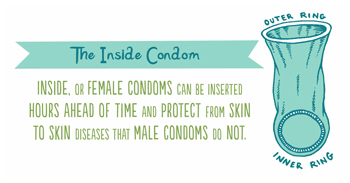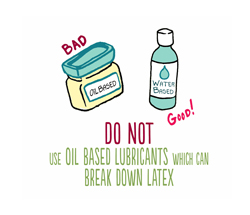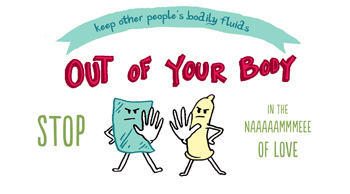Hooray for barriers! Not the crummy kind that keep us from things we want, the kind that can protect us from pathogens that can be passed from one person to another, resulting in in illness and infection. Safer sex barriers do a great job reducing our STI risks, so we’ve got the best chance of enjoying the good things sex can offer without big risks of transmitting (giving) or acquiring (getting) infections in the process. Barriers keep germs out while letting us do the things we enjoy, want and which can bring us closer; to our own sexuality and to other people we may share it with.
If we still want to engage in genital sex – like vaginal or anal intercourse, oral sex or manual sex – safer sex is one of the only things (besides available vaccines and PrEP and PEP for HIV prevention) yet proven to effectively reduce the STI risks those activities can present. That means regular STI testing, and consistently (not just sometimes) and correctly (used exactly as directed) using barriers. Most STIs are primarily transmitted through body fluids, so protecting ourselves against them is mostly about limiting or avoiding our contact with each others fluids. Barriers are what help us do that when we don’t also want to limit or avoid being sexual with other people.
How much protection do they offer? When used consistently and correctly, latex condoms are highly effective preventing STIs, and are the only thing that’s yet shown to be highly effective. With fluid-borne infections, like HIV, Hepatitis or Chlamydia, condoms have been found in studies to reduce the risk of infection by as much as 99%, and as little as around 50%, with both figures largely influenced by how consistently and correctly condoms are used. Specifically addressing HIV protection, the UNFPA states an effectiveness rate of 90-96%, Family Health International states a rate of 80% - 97% protection. With infections transmitted by skin-to-skin contact alone, findings for protection range from around 30% to around 90%. Again, proper use and consistency is a big player. Barriers can also help prevent infections like urinary tract infections and bacterial vaginosis.
Barriers protect us better from infections spread only or mostly by fluids than they do with those spread by skin-on-skin contact (like molluscum, HPV and Herpes). That’s mostly because most barriers do not cover the whole surface of the genitals of a person, their partner, or both. But the biggest player in how effective barriers are in preventing infection is just like with methods of birth control: it’s if they are used all the time, and also used properly. How effective a barrier is is far more within your control than outside of it: effectiveness has way more to do with always using them and using them right than it does with any limitations of the barriers themselves.
All you really need to use them well and get the protection they offer is to learn which ones you use for what activity or body part, how to use them properly and some practice, confidence and a commitment to the health and well-being of you and yours. We can give you most of that right here, and we can give you a good start to developing that last part for yourself.

Let’s start with the barrier people tend to be the most familiar with: condoms. We currently have two different options when it comes to condoms on the whole: the “male” (or outside) condom, and the “female” (or inside) condom.
Outside (“Male”) Condoms are the barrier to use for any kind of intercourse (vaginal or anal) or oral sex involving a penis.
While we know many of our readers feel they know the basics of putting on a condom, we’ve found that often people will have almost everything down, but either be flubbing something major, or are missing one piece of information that can make a big difference in how effective condoms are. And boy, can it ever suck to find out you haven’t been using them right after the fact.
How to Use Outside (“Male”) Condoms:
1) Use a condom that is new, and at least six months in front of the expiry date: make sure your condom is not expired. The expiration date is somewhere on every individual package. Be sure you’re also using a condom that hasn’t been kept anywhere where it could have gotten worn, or too hot or cold . We always need to keep condoms and all other barriers places with moderate temperatures, and store them only in places they won’t get too knocked around or sat upon.
2) Open the condom wrapper with your fingers: don’t use teeth or scissors if you can help it. Take it out, then roll it out a tiny bit so the edge is rolled up on the outside of the condom, facing up. Otherwise the condom won’t roll down right. Put a few drops of water-based lubricant inside the tip of the condom: that helps with getting it on, and makes condoms feel a lot better for the wearer during use.
3) Pinch and hold the tip of the condom with your fingertips to leave some space – about an inch – and roll the rest down the length of the penis while still holding the top. The ring of the condom should be as close to the base of the penis as possible. When you’re down to the base, run your fingers from the tip all the way down to press out any air bubbles: this helps keep condoms from breaking. (This isn’t necessary when using a condom to cover toys.)
4) Put some lube on the outside of the condom. The amount of lubricant already on lubricated condoms is rarely enough for the condom to feel good for everyone, and the lubrication the vagina or penis can produce by itself often doesn’t fare so well with latex: it’s easy for parts to feel dry and raw fast. Plus, a well-lubricated condom is a condom that is not at all likely to break. While you are using the condom, neither you nor your partner need to hold onto it: condoms are designed for hands-free use.
5) After ejaculation (or not, but you’re finished for now) – and before you withdraw – hold the base of the condom with your hand. Keep your hand there while you withdraw, and until the penis, or toy, is all the way out of the vagina, anus or mouth. Pull it off (slowly, so slowly: whipping condoms off fast usually ends in a mess, tears or unstoppable laughter) with that same hand on the rim of the condom and your other hand by the tip. Tie a knot near the base of the condom.
6) Throw the condom away in the rubbish bin - NEVER reuse condoms.
For those using outside condoms who’re uncircumcised, there’s a variation in putting a condom on. You, or your partner, will need to first gently move the foreskin back a bit, then put on the condom, rolling it about halfway down the shaft of the penis before letting go of the foreskin, and then rolling the condom down to the base. Because of the foreskin, you or a partner may find the condom doesn’t go as far down to the base as it does with a circumcised penis, and that’s okay. You also may find that using a few drops of lubricant inside the condom, before you put it on, is more important (or not) to your comfort than it is to those with circumcised penises. This is just another thing to practice with to find out what feels best for you.

Most of this is just going to be about working out what feels best for you and your own foreskin, insofar as how much you roll the foreskin down, and when you let it slide back up. Some people with foreskins even find that putting them on the same way you would without a foreskin is what works best for them. So long as the base of the condom is firmly on the base of your penis and it all feels comfortable for you, you’re good.
You can find condoms in pharmacies, grocery stores, gas stations, in clinics and health centers (often for free), or you can order them online. No barriers, including condoms, are only legal or available for people of a certain age: people of every age can purchase them lawfully.
Want more information on condoms? Check out these other pieces on the site:
- Condom Basics: A User’s Manual
- I Need To Better Understand How Condoms Can Protect me from STIs
- Your Map to the Condom Aisle
- Is it really illegal to sell me condoms? (No.)
- Birth Control Bingo: Condoms
- Breaking a No Condom Habit
- Love the Glove: 10 Reasons to Use Condoms You Might Not Have Heard Yet
 There are a LOT of brands and styles of condoms out there to choose from right now. So many choices! Yay! People are going to have some that don’t work for them, some that are fine, and others that are their Best Condom of Ever. If condoms don’t feel good, fixing that can sometimes be as easy as just using a different size, style or brand.
There are a LOT of brands and styles of condoms out there to choose from right now. So many choices! Yay! People are going to have some that don’t work for them, some that are fine, and others that are their Best Condom of Ever. If condoms don’t feel good, fixing that can sometimes be as easy as just using a different size, style or brand.
We’re fans of everyone knowing how to use condoms, not just people with penises or people who use condoms as a method of birth control. It can make it way tougher to get and keep in the habit of using condoms if we don’t all know how, or only one partner knows. If you don’t have a penis yourself, or a partner with one, that doesn’t mean you can’t still learn! You can learn to put condoms on by using a dildo, or food items like bananas or cucumbers. (Extra bonus: it’s kind of hilarious. As it turns out, bananas look silly with condoms on.)
With any kind of barrier, it can be harder to learn to use when we only practice with partners. Even when a partner is great and we feel great with them, there’s always an extra pressure just by virtue of someone else being involved, especially if we both also want to be sexual at the time, so we can be a little hasty or distracted. Learning to use, and practice using, barriers when you’re all by yourself makes becoming a pro with easier.
 Inside (“Female”) Condoms: Inside condoms may be the most underrated barrier there is.They’re amazing! An inside condom can be put in in advance of sexual activity, making it great for those who feel like outside condoms are an interruption, no matter how brief, they’d prefer not to manage. The materials they are made of conducts body heat better than latex condoms. They are made of a non-latex material, so are just as good for those who can’t use latex as those who can, and can also be used with even oil-based lubricants, unlike most outside condoms. They also don’t tightly grip the penis, so for those who dislike the tight feeling of the base with outside condoms, the inside condom can be a great way to get the protection we want without the feel of a standard condom.
Inside (“Female”) Condoms: Inside condoms may be the most underrated barrier there is.They’re amazing! An inside condom can be put in in advance of sexual activity, making it great for those who feel like outside condoms are an interruption, no matter how brief, they’d prefer not to manage. The materials they are made of conducts body heat better than latex condoms. They are made of a non-latex material, so are just as good for those who can’t use latex as those who can, and can also be used with even oil-based lubricants, unlike most outside condoms. They also don’t tightly grip the penis, so for those who dislike the tight feeling of the base with outside condoms, the inside condom can be a great way to get the protection we want without the feel of a standard condom.
They cost a little more than outside condoms, and can be harder to find, but if you have never tried one, we’d say it’s worth it. Inside condoms may just turn out to be your new favorite thing of ever. If you can’t find them where you buy condoms, they can be ordered widely online. You can also ask a pharmacy if they can order some in for you. If you’re in the U.S., you’ll need to get a prescription for them before you can get inside condoms from a pharmacy.
For those who used female condoms a few years ago and vowed never to do so again, because the material they were made of made louder sounds during sex than your mouth is even capable of making? They are not made of that material anymore. The new materials are soft, smooth, and best of all, perfectly quiet.
How to Use Inside (“Female”) Condoms:
1) Just like with outside condoms, you want to first open the package carefully with your fingers.
2) Then, put a little lubricant on the outside of the closed end. As the illustration above can show you, the inside condom has two rings, an inner one in back, where the material covers it completely – where it is closed – and an outer ring in front, where there is an opening to the condom, just like with an outside condom.
3) Next, you will need to insert it inside the vagina, or anus, depending on what kind of genital sex you are choosing to do. Some put the inside condom inside while they stand with one foot up on something, or squat, or sit on the edge of a chair or toilet, or lay down. You’ll find out by experimenting what works best for you. Inside condoms can be inserted up to 12 hours before use, so if you prefer to put it in way before sexual activity, you can do that.
You’ll squeeze that inner, or back ring, together with your fingers until it basically makes a line, and put it inside the body the way you’d put in a tampon or menstrual cup, pushing it gently back as far as you can. With vaginal insertion, until it reaches your cervix (which feels like a little nose inside the vagina, if you have never felt it before). When it’s all the way back, you pull the finger you pushed it inside with out, and let the outer ring of the condom hang about an inch outside the vagina or anus.
4) Then, a partner will insert their penis – or a toy – inside the vagina or anus and the condom inside. The base will not grip them like an outside condom’s base does. For those new to sex or using this kind of condom, do be sure and check that the penis, or toy, is being inserted inside the condom in the vagina, rather than to the side of the condom.
5) To remove the inside condom, you will have your partner withdraw – no need to hold anything. Then you twist the outer ring, and the part of the condom outside your body until it’s closed, gently pull it out and throw it away.

Dental dams are the barrier we have to help reduce our risks of infections during cunnilingus (oral sex involving the vulva) or analingus (oral sex involving the anus). Some people have the idea that oral sex with someone with a vulva does not pose STI risks. While oral sex risks are higher when there is a penis involved, rather than a vulva, please know that does not mean cunnilingus poses no risks, or is an activity where it’s sound not to protect yourself or your partners. It does still present STI risks, particularly with common infections like Gonorrhea, HPV and the Herpes virus.
Like condoms, dams come in both latex and non-latex. Like condoms, they also are available with or without flavoring, if you have preferences in this regard.
How to Use Dental Dams:
Open the package carefully, take out the folded square and open it up – it’s like the littlest bedsheet on earth, and you just want to open up that sheet like you were making the littlest bed. You and/or the person whose vulva, or anus, is having the dam put unto may want some lube on their genitals before putting it on. Then you, or they, just place it over the genitals, and you, or they, hold it there with hands during sexual activity.
 That may sound like a stumper, until you think about how often you’re usually also using your hands anyway with cunnilingus or analingus. Basically, all you’re doing with the dam is having the edges of it stay between where your fingers might be anyway, or your partners, and being a little mindful about that to keep it in place.
That may sound like a stumper, until you think about how often you’re usually also using your hands anyway with cunnilingus or analingus. Basically, all you’re doing with the dam is having the edges of it stay between where your fingers might be anyway, or your partners, and being a little mindful about that to keep it in place.
Make sure the same side of the dam that’s been against the body stays on that side.(Pro-tip from one of our volunteers: use a permanent marker to put an irreversible word/letter on the corner of one side if you’re worried about spacing which side is which.) When you’re done using it, throw it away, and as with other barriers, don’t reuse: you need a new dam for any additional sexual activities, or if you want to change the part of body you are using it on, like, for example, starting with cunnilingus and shifting to analingus.
Dams can be tricky to find in some areas, or for some populations – like younger people. If they aren’t available where you already purchase condoms, they can be found online.If online ordering won’t work for you, that doesn’t mean you have to go without! You can make a dam by cutting a condom lengthwise, or by cutting a glove: check out these easy instructions for DIY damsexternal link, opens in a new tab. You also have the option of using Saran Wrap or Cling Film instead, just don’t choose the kind expressly for microwave use, since, as it tells you on the box, that kind has tiny perforations in it intended to let steam out, but which would also let germs in.
Want more information on dental dams and related issues? Take a look at these links:
- Figuring Out How to be a Lesbian Safer Sexpert
- Safer Sex: Do Women Sleeping with Women Need It?
- What exactly is a “rim job?”

Gloves and finger cots can be used to reduce the risk of infections with manual sex, like fingering, handjobs, or any kind of anal play with the hands. While manual sex poses far less risk of infection than intercourse or oral sex do, and handwashing does a great job by itself at reducing risks, gloves and finger cots still have some good things to offer. Like condoms, you can find both latex and non-latex options.
For instance, they make things feel better for some people. Genital tissue is tender, and hands, fingers, or nails can be rough, even when we take good care of them. Callouses and hangnails can cause abrasions that don’t feel good and increase our risk of infections. Gloves feel slick and uniformly smooth; that not only tends to feel mighty-nice, it helps prevent small genital tears or abrasions which do not feel mighty-nice at all. It can also be harder to wash our hands sometimes or in some settings, and gloves or finger cots give us the ability to change them, without having to run to the bathroom for another handwash, between activities easily.
You probably already know how to put on a glove: you just put your fingers and thumbs inside. Just know that hands need to be dry before using them, otherwise they can be harder to put on. You also want to avoid using the kind of latex gloves with powder inside when using gloves for genital sex. As with other barriers, lube plays a big role in things feeling good. As with other barriers, you don’t want to reuse gloves. You want to use them for sexual contact with one specific body part only: a different sexual activity means a new glove is needed. To take them off, pull from the base of the glove, at your wrist, towards your fingertips. The glove will turn itself inside out as you pull it off from the bottom. That makes getting them off easier, and also keeps all those fluids inside when you toss it.
Finger cots look like really tiny condoms: you just roll one on a fingertip (or more than one, if you like!), when you are going to use just fingertips for something. You know the drill: lube, one cot per activity or place, no reusing, roll them off and toss’em when you’re done.
Gloves are available at pharamcies, and sometimes even at grocery stores (look in the drugstore aisle). Finger cots can be found online.
Sex toys, like people’s bodies, can also carry, harbor and transmit pathogens. Many can’t be boiled, and are made of porous materials that pathogens like hanging out in. If you want to be safe with your toys, even when you’re the only one using them, you want to cover any toy that can’t be boiled or otherwise safely and effectively sanitized, and use a new barrier with every use. Ideally, you don’t want to be sharing most toys, but if and when you do share, or plan to, using barriers is important for everyone’s best health. Using barriers with toys also often makes cleaning them and keeping them clean a whole lot easier!
 Condoms cover dildos and other long-shaped toys well, and you can also drop a small, corded vibrator, like bullet styles, into a condom and cover it that way. For sleeves or pumps, toys meant for the insertion of penises, you simply use a condom like you would for intercourse while using it. If you are using household objects for masturbation, they very much should be covered, but even if they are, they shouldn’t be shared. For several reasons, some pretty basic etiquette and good-neighborliness among them.
Condoms cover dildos and other long-shaped toys well, and you can also drop a small, corded vibrator, like bullet styles, into a condom and cover it that way. For sleeves or pumps, toys meant for the insertion of penises, you simply use a condom like you would for intercourse while using it. If you are using household objects for masturbation, they very much should be covered, but even if they are, they shouldn’t be shared. For several reasons, some pretty basic etiquette and good-neighborliness among them.
Finger cots can also cover small toys. If you feel stumped about what to use, a dam can be a good option, because you can wrap almost anything in it and have plenty of it left to hold unto. You can also use a dam (or condoms) for safer sex with toys by putting it on your body part you were going to contact with the toy.
Don’t forget!
Latex barriers should not be used with oils or oil-based lubricants, as most will degrade the latex. The easiest way to be sure you’re using the right lube? If it says it’s latex safe, and/or meant for sexual (or vaginal) use, you’re good. When in doubt, stick with something water-based or, if you want to get more adventurous with your lubes, do so only when using non-latex barriers.

Barriers are usually easy to use once you get the hang of them and get into the habit of consistent use. They’re easy to learn to like once we feel confident and capable with them: when using barriers feels like a major drag, it’s often because one or more of the people using them, or thinking about it, doesn’t feel experienced enough using them, or doesn’t know how to use them in the ways that feel good yet. Learning how to use them and getting practice can not only help them to be most effective, it also will typically help people feel a lot more chill and happy about them emotionally and socially.
Three Ways to Make Using Barriers Feel Easier:
1) There’s no perfect thing to say to convince a person who does not want to use barriers to use them. There’s also no special way we need to ask – beyond something like, “Can you/we use a condom/dam/glove, please?” – or even can ask to make magic happen and change someone’s mind on this.
Letting go of any expectation you will ever need to say anything to someone who refuses EXCEPT, “Oh well, seeya later then,” can make you feel more relaxed pretty instantly about inviting partners to use barriers with you. You don’t ever, seriously, ever, have to have arguments about this or write a fully cited thesis to try and prove your point to a partner. You just need to offer, and if they don’t accept, just graciously choose not to have sex with them.
If your words feel clumsy or uncomfortable,the easiest, simplest way to ask someone to use a barrier is just to hold it out and offer it to them before you do what you were about to start doing. That’s it. So easy. And it works very, very well.
You don’t even need to use any words; you often won’t have to, since most people know what barriers are for. When you’re about to do something sexual and you just take out the barrier and hold it out, or start putting it on yourself, most people get that barriers are a given if they want to have sex with you, and they will just get right on board if sex with you is something they want. (Or, they may feel the same way, you just pulled out the barrier before they did!)
All people asking each other to use barriers is is just someone, or more than one someone, actively caring for their health and that of their partner in a very basic, noninvasive way and asking for cooperation with that. You may need to negotiate or adjust some things, like what style or kind of material or lube someone likes, talk about testing, or show a partner how to use a barrier. But really, just taking it out and using it or handing it over – or words as clear and simple as, “Can you/we use a condom/dam/glove, please?” – should generally suffice. Which leads us to…
2) Keep barriers (and lube!) on hand. Don’t rely on others to have them, or set things up so only one partner is responsible for getting them. Share in both the freedom and responsibility of having them yourself! If you want to offer them to partners, you obviously need to have them in the first place. Plus, when barriers aren’t used when they’re needed, it’s often because no one has them handy when they need them, and both people were assuming the other person would.
3) Know and understand: a barrier against pathogens is not a barrier to intimacy, to closeness, bonding or pleasure. A LOT of people think or believe those things, and this is a case where thinking or believing a thing actually CAN make it so. We know from study that those negative thoughts influence people’s experience of condoms. People who think condoms or other barriers are a drag, or get in the way of closeness or pleasure often wind up experiencing them exactly that way because they strongly believe those things to be true. On the other hand, people who don’t believe those things, who think neutrally or positively about barriers, often experience intimacy, closeness, pleasure and bonding while still using barriers. Because barrier use also often involves communication, honesty and mutual care, it, and the skills we hone when practicing safer sex together, can actually help facilitate and support intimacy and pleasure, rather than standing in their way.
Look, we can’t always stay healthy. We’re people, we get sick sometimes. STIs are very common, especially among those in their late teens and 20s: they are challenging to avoid. Some people have already contracted an STI early, especially since so many people don’t use barriers right from the start, don’t use them with all kinds of genital sex, or have not used them consistently or correctly. It happens, and like any illness, it’s not something anyone needs feel shame around, even if and when they contracted an STI by knowingly choosing to take risks. Rather, it’s something to get better from or cope with, changing what habits you need to to better support your health in the present and future, just like with any other kind of illness.
 We obviously want to avoid STIs or transmitting them whenever we can, just like we want to avoid getting or passing on strep throat. Using barriers is about doing something basic to protect our health and that of others, like covering our mouths when we cough, washing hands before eating, or staying home when we’re sick instead of giving everyone the flu. It’s also harder to feel a desire to be intimate, and to experience pleasure when we’re sick.
We obviously want to avoid STIs or transmitting them whenever we can, just like we want to avoid getting or passing on strep throat. Using barriers is about doing something basic to protect our health and that of others, like covering our mouths when we cough, washing hands before eating, or staying home when we’re sick instead of giving everyone the flu. It’s also harder to feel a desire to be intimate, and to experience pleasure when we’re sick.
These kinds of barriers? Good stuff. Good stuff that even helps the good stuff stay good stuff, even. Once you know what they are and how to use them, and get some practice with them under your belt (as it were), they’ll likely turn out to be one of the easiest things you do to protect your health and also one of the things you do in your sex life that leaves you feeling highly empowered, capable and in control of your body and health.
